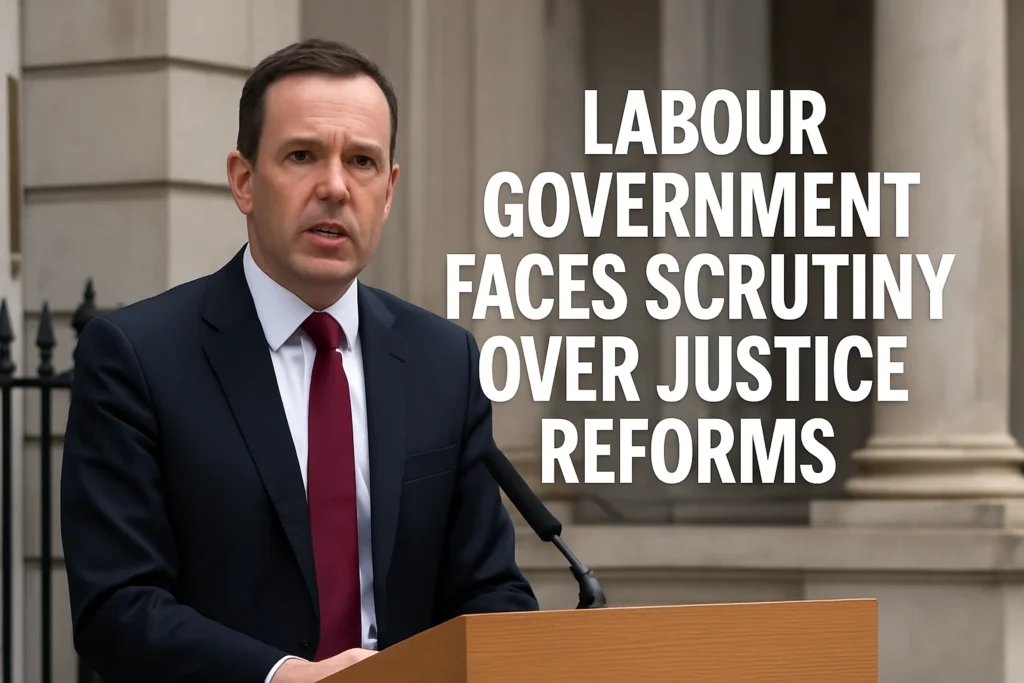Introduction: The Scales of Justice and a Crowded House
Imagine a balancing scale, where on one side rests the need for safety and punishment, and on the other, the hope for reform and a fair chance. This delicate balance is at the heart of any justice system, and right now, in Britain, those scales are feeling particularly wobbly. The Labour government, much like any party in power, is facing intense scrutiny over how it’s handling the country’s prisons and broader legal system.
For years, the story of Britain’s prisons has been one of growing numbers and shrinking space. This isn’t just about statistics; it’s about real lives, real communities, and the very idea of what justice means. Recently, the debate has become louder, focusing on issues like crowded prisons and the controversial decision to let some prisoners out early. This isn’t an easy problem to solve, and it raises big questions: How do you keep the public safe while also ensuring prisons aren’t bursting at the seams? And what happens when political promises meet the harsh realities of a complex system? Let’s delve into this challenging situation and understand the different voices in this important conversation.
The Squeeze in the Cells: Understanding Britain’s Prison Capacity Crisis
For quite some time, a quiet alarm has been sounding within the walls of Britain’s prisons. It’s the sound of too many people in too little space – a problem known as the prison capacity crisis. Imagine a school that suddenly has twice as many students as it was built for, with no extra classrooms or teachers. That’s a bit like what’s happening in many UK prisons.
Why Are Prisons So Full?
The reasons for this overcrowding are complex, not just one single cause:
- Tougher Sentencing: Over the past few decades, laws have often become stricter, and judges are sometimes told to hand down longer sentences for various crimes. This means people stay in prison for longer periods.
- More People in Custody: A rise in arrests for certain crimes, combined with slower court processes, can mean more people are being held in prison while they wait for trials or after they’ve been sentenced.
- Old Buildings, Slow Construction: Many of Britain’s prisons are very old, some dating back centuries, and weren’t designed for today’s prison populations. Building new prisons is a huge, expensive, and time-consuming task, and it hasn’t kept pace with the rising numbers.
- Reduced Funding for Alternatives: In the past, there might have been more community-based sentences or programs that kept people out of prison, especially for less serious crimes. Cuts to funding in these areas can mean prison becomes the only option.
This overcrowding isn’t just uncomfortable; it creates serious problems. When prisons are too full, it’s harder to keep order, provide education or training programs that help prisoners turn their lives around, and ensure the safety of both prisoners and staff. It’s like a pressure cooker, and sometimes, that pressure builds to a boiling point.
A Difficult Choice: The Debate Over Early Prisoner Release
In the face of dangerously full prisons, the government has sometimes resorted to a controversial measure: early prisoner release. This means allowing some prisoners to leave jail a short time before their original release date. It’s a bit like letting students out of school five minutes early because the classrooms are too packed.
The Emergency Release Scheme
Recently, the Labour government has defended its use of an early release scheme, pointing to the urgent need to create space in prisons. This specific scheme allows certain prisoners to be released up to 70 days early. It’s important to understand that these aren’t typically violent offenders or those serving very long sentences. The scheme usually targets prisoners who are nearing the end of their sentence anyway and who have committed less serious crimes. They are also often released with strict conditions and supervision from probation services.
Why It’s Controversial
Despite the government’s reasons, early release schemes always spark heated debate and strong reactions:
- Public Safety Concerns: This is the biggest worry. Many people, including police and security chiefs, immediately question whether letting prisoners out early, even for a short time, puts the public at greater risk. They warn that any reduction in time served, no matter how small, could harm public safety if not managed perfectly. For families of victims, it can feel like justice isn’t fully served.
- Fairness and Justice: Some argue that if someone has been sentenced to a specific amount of time, they should serve that full time. Early release can undermine public confidence in the justice system.
- Recidivism Risk: A key question is whether prisoners released early are more or less likely to commit new crimes. If they are released without proper support or supervision, the risk of them returning to crime (known as recidivism) might increase.
It’s a tough decision for any government: prioritize space in prisons, or guarantee that every minute of a sentence is served? The choice often puts them directly in the line of fire.
Voices of Concern: Police, Security Chiefs, and the Opposition
When the government makes difficult decisions about justice, it’s never in a vacuum. Powerful voices quickly weigh in, expressing their concerns and demanding accountability. In the current debate over early prisoner release, some of the loudest warnings have come from those on the front lines of public safety.
Warnings from the Front Lines
- Police Chiefs: Leaders within the police force have expressed significant apprehension. Their primary role is to protect communities, and they often see the immediate impact of crime. They worry that any measure that reduces time spent in prison, no matter how well-intentioned, could potentially lead to more crime on the streets if not managed with extreme caution. They carry the responsibility of dealing with any new offenses committed by those released.
- Security Chiefs: Experts in national security and intelligence also voice concerns, particularly if the early release policies inadvertently affect individuals with connections to more serious or organized crime. Their warnings often focus on the broader implications for national security.
- Probation Services: While working with released prisoners, probation officers can also feel the strain. If more prisoners are released with less time for preparation or with stretched resources, it puts immense pressure on their ability to manage and support individuals effectively, potentially increasing risks.
The Political Battleground
Beyond the operational concerns, justice reform quickly becomes a political football. Opposition parties seize on issues like early release to criticize the government’s handling of the justice system.
- Accusations of Mismanagement: Opposition leaders often accuse the ruling Labour party of “mismanaging justice system challenges.” They argue that the prison overcrowding problem should have been foreseen and addressed through better long-term planning, rather than relying on emergency measures like early release.
- Calls for Transparency: There are demands for more transparency about exactly who is being released early, why, and what measures are in place to monitor them.
- Focus on Alternatives: Opposition parties often push for alternative solutions, such as investing more in crime prevention, rehabilitation programs within prisons, or community sentences that are tough but keep people out of overcrowded jails.
This constant push-and-pull between government and opposition highlights the complexities: there are no easy answers when balancing the need for punishment, rehabilitation, and public safety.
Balancing Act: Reform vs. Public Safety
The core challenge facing the Labour government, and indeed any government grappling with a justice system, is a delicate balancing act. On one side of the scale is the urgent need for justice system reform – modernizing prisons, reducing overcrowding, ensuring humane conditions, and focusing on rehabilitation. On the other side is the fundamental promise of public safety – protecting citizens from harm and ensuring that criminals serve their time.
The Pressure to Reform
Reformers argue that simply locking up more people for longer isn’t always the answer. They point to the problems caused by overcrowding:
- Reduced Rehabilitation: When prisons are too full, there’s less space and staff for education, job training, and addiction treatment programs. These programs are vital for helping prisoners avoid returning to crime after release.
- Increased Violence: Overcrowded conditions can lead to more stress, tension, and violence within prisons, making them less safe for both prisoners and staff.
- Cost: Keeping people in prison is incredibly expensive for taxpayers. Finding more effective and sometimes less costly alternatives can free up resources.
The goal of reform is often to create a system that not only punishes but also truly changes lives, making society safer in the long run by reducing repeat offenses.
The Imperative of Public Safety
However, the public’s primary concern is often immediate safety. News of crime is impactful, and any perceived leniency towards offenders can cause alarm.
- Fear of Repeat Offenders: The biggest fear with early release is that a prisoner who is let out will commit another crime, potentially a serious one.
- Victim’s Rights: For victims of crime and their families, ensuring that offenders serve their full sentence is a crucial part of justice and healing.
- Deterrence: Some argue that tough sentences and consistent prison time are essential to deter others from committing crimes.
The government is constantly caught between these two powerful forces. Defence of their policies, like that offered by Housing Minister Matthew Pennycook, often involves stressing that difficult decisions are being made with public safety as a primary concern, even when facing tough choices about prison space. They must explain why measures, like early release, are deemed necessary given the current pressures, while also outlining steps to mitigate risks.
Looking for Solutions: Beyond Early Release
While early release might be a short-term fix for prison overcrowding, it’s widely recognized that lasting solutions require deeper changes to the entire justice system. The conversation extends beyond just how many beds are available to how society treats crime and punishment.
Investing in Prevention and Rehabilitation
- Early Intervention: Addressing the root causes of crime, such as poverty, lack of education, or mental health issues, can prevent people from entering the justice system in the first place.
- Community Sentences: For less serious crimes, robust community sentences can be a more effective alternative to prison. These might involve probation, community service, or participation in rehabilitation programs, often allowing offenders to maintain employment and family ties.
- In-Prison Programs: Even within prisons, increased funding for education, vocational training, and therapy can significantly reduce recidivism rates. Helping prisoners gain skills and address personal issues makes them less likely to re-offend upon release.
Modernizing the System
- Building New Prisons: While expensive, building new, modern prisons that are designed to facilitate rehabilitation and provide adequate space is a long-term goal.
- Improving Court Efficiency: Speeding up court processes means fewer people are held in remand (pre-trial detention), which can also ease prison overcrowding.
- Data-Driven Decisions: Using data and research to understand what truly works in reducing crime and managing offenders can lead to more effective policies.
The challenge for any government is to implement these long-term strategies while simultaneously managing the immediate pressures of a stretched system. It requires significant investment, political will, and a shift in public perception about the purpose of incarceration.
The Broader Context: Justice System Challenges in the UK
The current debates around prison capacity and early release are just one part of the larger picture of justice system challenges in the UK. The system is a complex web of police, courts, prisons, probation, and support services, and each part faces its own set of pressures.
Other Key Challenges
- Backlogs in Courts: Long delays in court cases, partly worsened by the pandemic, mean that trials can take years to happen. This creates uncertainty for victims and defendants and keeps people in prison on remand for extended periods.
- Funding Shortages: Many parts of the justice system, including policing, courts, and probation, have faced budget cuts over the years. This can impact staffing levels, training, and the quality of services.
- Recruitment and Retention: Attracting and keeping skilled staff in prisons, probation, and even the legal professions can be difficult, leading to staffing shortages and increased workload for existing personnel.
- Digital Transformation: Modernizing the justice system with new technology is crucial for efficiency, but it’s a huge task that requires significant investment and careful implementation.
- Public Confidence: Maintaining public trust in the fairness and effectiveness of the justice system is vital, especially when controversial decisions or high-profile cases dominate the news.
These challenges are interconnected. For example, court backlogs contribute to prison overcrowding, and funding shortages impact the ability of probation services to effectively supervise released prisoners. Addressing one issue often requires tackling several others simultaneously.
Conclusion: A Continuous Pursuit of Balance
The Labour government’s approach to justice reform, particularly concerning prison capacity and early prisoner release, is a microcosm of the larger, continuous struggle to balance tough decisions with societal needs. It’s a complex narrative where the desire for public safety meets the practical limits of a stretched system and the philosophical goals of rehabilitation.
As Housing Minister Matthew Pennycook and others in government navigate these choppy waters, they face the constant pressure of criticism from police and security chiefs, who warn of public safety risks, and from opposition parties, who highlight perceived mismanagement.
Ultimately, the story of Britain’s justice system is one of ongoing adaptation. It’s a conversation that requires careful listening to all voices – those of victims, offenders, law enforcement, and the public – to continually seek a delicate balance where justice is served, communities are safe, and every individual has a chance for a better path. The scales of justice are always in motion, and the pursuit of equilibrium is a never-ending journey.



